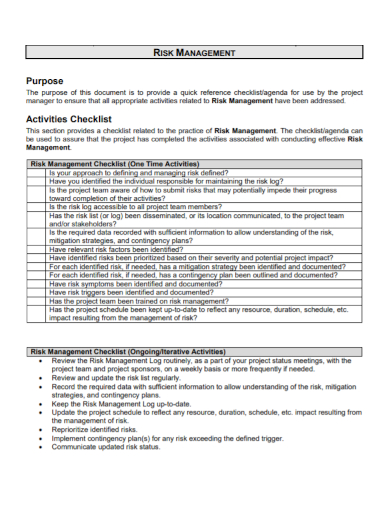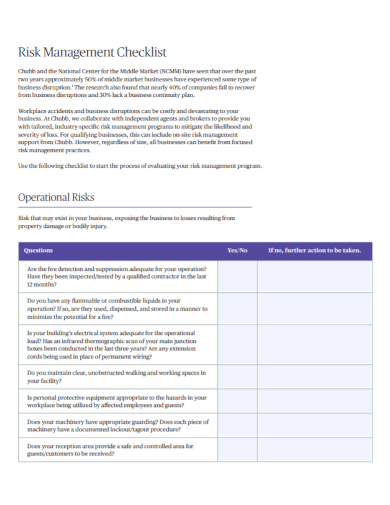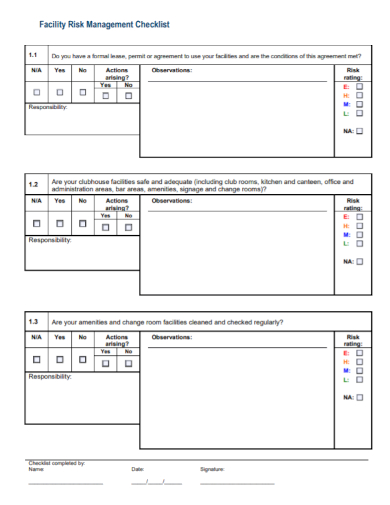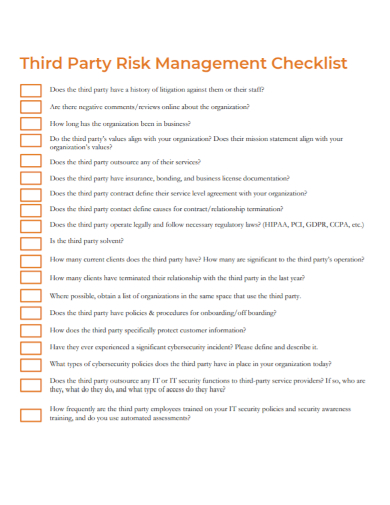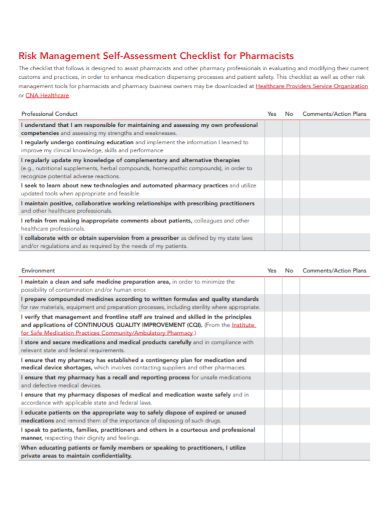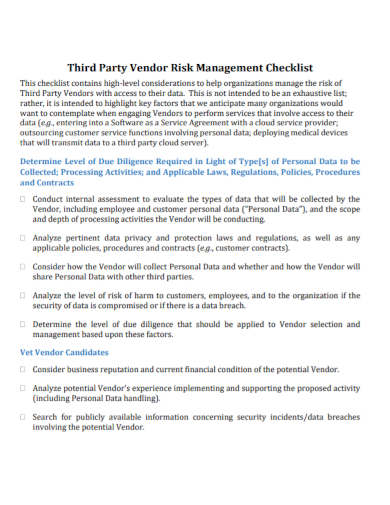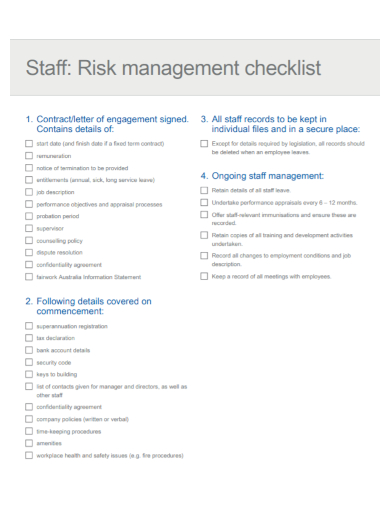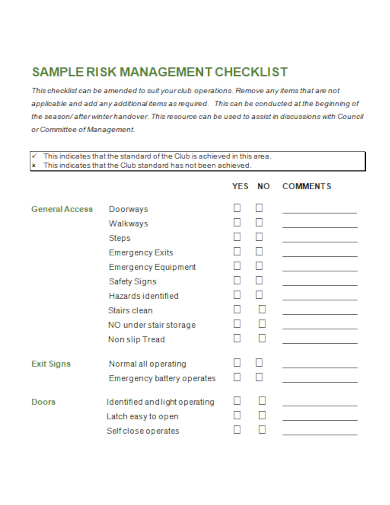An unprotected organization is liable to various risks and threats. Failure to properly assess, prevent, and mitigate the effects of any sort of risks can have the potential to completely destroy your organization. You can lose market share if you don’t anticipate the hazards of shifting conditions. If you don’t plan ahead for the dangers of developing your business, you could lose a lot of money. Thus, being able to foresee such threat and prepare the course of action in response of a crisis is crucial to the well-being of any company or non-profit organization. In this article, we provide you with free and ready-to-use samples of Risk Management Checklists to help you prepare and plan. Keep on reading to find out more!
10+ Risk Management Checklist Samples
1. Checklist Risk Management Essentials Template
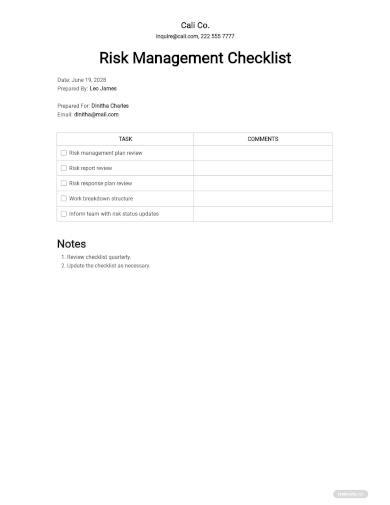
2. Home Office Risk Management Checklist Template
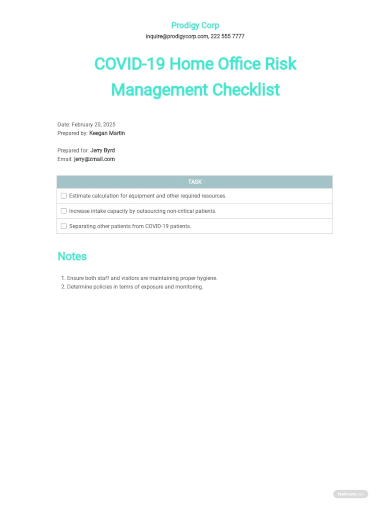
3. Risk Management Activity Checklist
4. Operational Risk Management Checklist
5. Facility Risk Management Checklist
6. Third-Party Risk Management Checklist
7. Risk Management Self Assessment Checklist
8. Internal Crop Risk Management Checklist
9. Third-Party Vendor Risk Management Checklist
10. Staff Risk Management Checklist
11. Sample Risk Management Checklist
What Is a Risk Management Checklist?
The goal of risk management is to detect possible problems before they happen so that risk-handling activities can be planned and implemented as needed throughout the product or project’s life cycle to reduce negative effects on accomplishing goals. Risk checklists are a catalog of dangers that have been discovered or experienced on previous projects. On all projects, risk checklists should be shared between the managers and risk management team.
A risk management checklist is a tool that allows you to list all of the topics that you and the other project stakeholders should be aware of in connection to project risk management.
How to Make a Risk Management Checklist
All risk management projects are built on the foundation of a thorough risk management checklist. Aside from the variety of downloadable templates of Risk Management Checklists available above, you can also try to make one of your own from scratch. Checklists may differ from company to company, but if you’re interested in making one that is personalized to your own project, here are some general information you should remember:
1. Recognize the threats.
Identifying the risks that need to be controlled should be the first step on a risk management checklist. In the case of professional dangers, this frequently entails looking back at previous errors or mistakes made by a professional and reviewing their processes to discover habits or techniques that could expose them to liability. There are many various strategies for identifying hazards, and which one you employ will depend on your resources, team, and project size.
2. Evaluate and appraise each prospective risk’s consequence, impact, and probability.
Potential risks must be assessed and prioritized once they have been identified. The risk manager must assess the severity of each risk and evaluate whether any existing control measures exist that could be useful in reducing or eliminating it. This information aids in the prioritization of hazards in terms of their severity.
3. For each danger, propose a prevention strategy.
For the various potential risk scenarios, the checklist should have a response strategy in consequence. Begin adopting control measures with the goal of entirely eliminating the risk. If a danger cannot be completely eliminated, it should be reduced as much as practicable. A single control measure may not always be as successful as a collection of control measures that act together to reduce or eliminate a given risk.
4. Assign each risk with an individual with specific roles and responsibilities.
Each risk should be assigned to a member of the team, prioritized, and given an estimate of the resources required to address it. After all, it’s not enough to jot down potential dangers and hope they don’t materialize.
FAQs
How will you deal with failure and risk?
Identify, source, and reduce the strategy’s risks ahead of time. Ensure that strategy is communicated and implemented consistently across the organization.
In the corporate world, what are the four forms of risk?
Financial hazards can be classified in a variety of ways. Separating financial risk into four main areas, such as market risk, credit risk, liquidity risk, and operational risk, is one method for doing so.
Is there a distinction between risk and risk management?
The macro-level process of assessing, analyzing, prioritizing, and devising a strategy to reduce threats to an organization’s assets and earnings is known as risk management. Within risk management, risk assessment is a micro-activity.
Define how you will handle any risks to guarantee that you can recognize, minimize, or eliminate problems as they arise to ensure the success of your project. If you download our customizable and printable samples of Risk Management Checklist today, you can start in effectively managing and handling plausible risk that might come your project’s way.
Related Posts
FREE 11+ Change Management Samples
FREE 11+ Construction Risk Assessment Samples
FREE 10+ Charity Risk Assessment Samples
FREE 10+ Child Care Risk Management Plan Samples
FREE 10+ Questionnaire Checklist Samples
FREE 10+ Property Management Checklist Samples
FREE 9+ HIPAA Security Risk Analysis Templates
FREE 8+ Sample Manual Handling Risk Assessment
Checklists to Boost Efficiency and Reduce Mistakes
FREE 15+ Sample Project Management Plan
FREE 14+ Sample Project Checklists
FREE 10+ Sample Project Management
FREE 10+ Traffic Management Plan Samples
FREE 10+ Scope Management Plan Samples
FREE 9+ Sample Risk Management Plan

